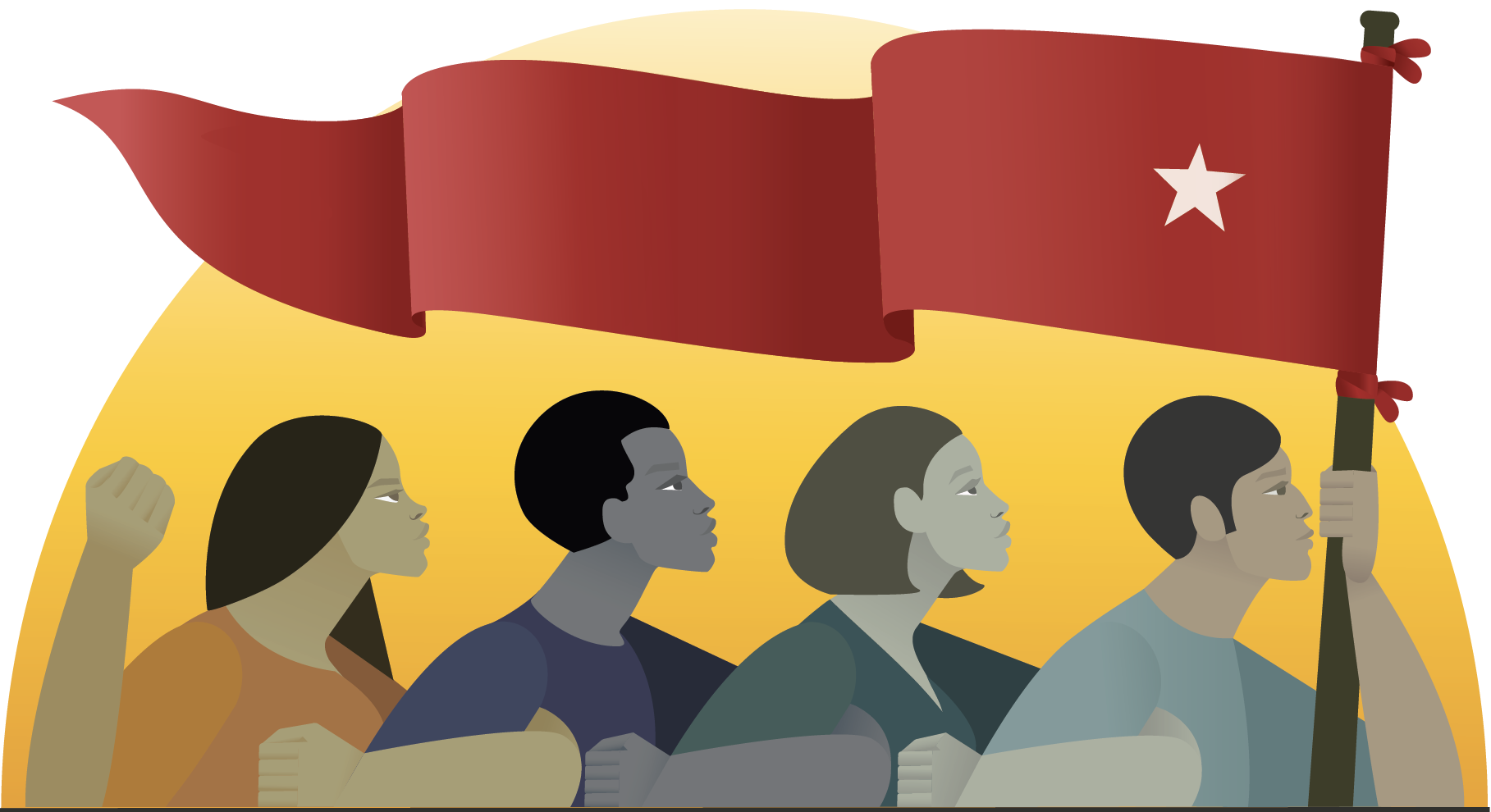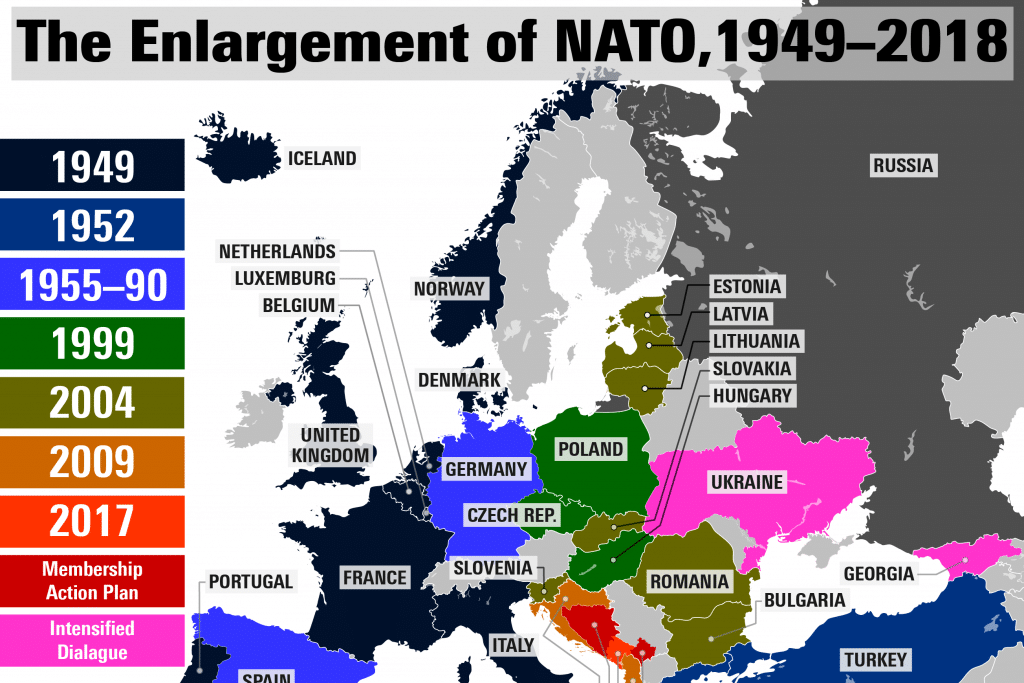War, no matter how geographically distant, persistently affects you and your community. Case in point is how Russia’s invasion of Ukraine is rocking the global economy. Prices of oil, wheat, and other basic commodities skyrocket as a result of the Russia-Ukraine conflict and sanctions imposed by the West. That being said, economies and peoples around the world are enduring the ripples of the violent situation unfolding in Eastern Europe.
As the invasion of Ukraine escalates, the number of casualties continues to rise, millions are forced to flee as neighborhoods are reduced to rubble. At first glance, the situation might seem straightforward – Russia is launching an “unprovoked” attack against Ukraine. With the mainstream media’s oversimplified Russia-versus-the-world narrative, and often racist framing of the issue, there is a need to understand the people, their motivations, and the powers at play that led us to this point.
What is not being said are the roles of imperialist countries in Europe’s worst security crisis since World War II. The bigger picture would not be complete without discussing the history between Russia, Ukraine, and the US’ unsolicited interventions.
GUNBOAT DIPLOMACY
Back in 1991, Russia, Belarus, and Ukraine signed the Belovezh Accords (also known as the Minsk Accords) which stipulated the disbanding of the Soviet Union. Another major provision of the agreement was that signatories would form the Commonwealth of Independent States (CIS) whose sovereignty will be respected. According to Moscow, the US-led North Atlantic Treaty Organization (NATO) made an assurance back in ‘89 and ‘90 to not expand their membership into Warsaw Pact members.
However, not even a decade later, NATO had already reneged on their purported guarantee when they launched aerial bombings in Yugoslavia dubbed as Operation Allied Force. Despite the operations violating the UN Charter outlawing the use of military force, the US received nothing more than a slap to the wrist for this war crime.
Movement for a Democratic Slovakia member Augustin Marián Húska said that “the NATO war against Yugoslavia in 1999 was also a signal to us, to not pursue any vision of political independence anymore. We have seen what will happen to forces that want to be independent.”
Through gunboat diplomacy, US-NATO has been successful in making an example out of Yugoslavia and, in essence, was able to dissuade other countries in the region to vie for autonomy. Eventually, former Soviet bloc members Czech Republic, Hungary, Poland, Lithuania, Estonia, Latvia, and Slovakia joined NATO. This is relevant now because this is precisely why NATO was able to deploy thousands of troops and set up military bases and missile networks so close to Russia in Latvia, Estonia, Slovakia, Poland, Romania, among others. Conveniently for NATO, in 2019 the US unilaterally withdrew from the 1987 Intermediate-Range Nuclear Forces Treaty which banned the production and development of ground-based missiles. For decades, the US-NATO has been laying the groundwork to secure their economic, military, and political interests in Europe. These are all glaring displays of the US wielding its military power, a mere preface of what has to come.
COUPS GOING VIRAL
In the Maidan protests of 2013-2014, then Ukrainian president and known Russia-supporter, Viktor Yanukovych was ousted through an Obama-supported coup to install a rabid anti-Russian government. A phone call was uploaded on Youtube between Victoria Nuland, US President Obama’s central agent handling Ukraine, and Jeffrey Pyatt, America’s ambassador in Ukraine. Nuland, in the phone call, was urging Pyatt to select the far-right and anti-Russian Yatsenyuk to succeed Yanukovych.
A second conversation was leaked a few weeks later. This time, Estonia’s Foreign Minister, Urmas Paet was sharing evidence to European Commission’s Catherine Ashton suggesting that planted snipers instigated the violence in the Maidan protests. This led to casualties from both the demonstrators and the police and eventually, to the ousting of Yanukovych.
The new right-wing administration, whose key members subscribe to radical nationalism and neo-Nazi ideas, wasted no time to feed the anti-Russian sentiments. They banned Russian books and mandated all print media in the country to be published in Ukrainian. This alienated several of its regions such as the Donbas and Crimea which are predominantly of Russian descent.
REFERENDUMS AND REVOLUTIONS
In February 2014, Ukraine was in dense political unrest and reeling from the anti-Russian policies of the new regime. Before the month ended, Moscow deployed troops in masks to clinch Crimea’s Supreme Council and secure strategic zones in the Crimean peninsula. Known as the Crimean status referendum, locals were given ballots with two options. The first would be to join the Russian Federation, while the second is to restore the 1992 Crimean constitution and remain part of Ukraine. Considering that the Crimean population is 60% ethnic Russians, support for Russia was already expected. With a turnout of 83.1%, around 97% voted in favor of integrating into Russia.
Expectedly, the White House, Ukraine, the European Union, NATO, and even the United Nations did not recognize the referendum deeming it “illegitimate” and “illegal”. The Russian regime of Vladimir Putin, seemingly unfazed by the heavy economic sanctions imposed by the West, continues to recognize Crimea as a federal subject of Russia.
More importantly, we have to understand the developments in Ukraine’s southeastern region of Donbas. Even before the rise and fall of the Soviet Union, Donbas has always been predominantly Russian in terms of population, culture, and history. It was considered as Ukraine’s “industrial heartland” but has been the locus of armed struggle and political turmoil in recent years. Shortly after the annexation of Crimea, thousands of Donbas citizens marched to the streets calling for a similar referendum to join Russia. Government buildings in Donbas were seized by the armed separatist movement. Ukraine’s capital Kyiv along with their Western Allies accused Russia of supporting the secessionists to which Moscow replied that the Russians involved in the conflict were volunteers. The resistance, having won control of Donbas, declared the founding of the People’s Republic of Donetsk and Luhansk. Despite this pronouncement, Russia did not recognize their sovereignty.
Determined to reclaim the region, from 2014-2018, Ukraine launched Anti-Terrorist Operation (ATO) – a counter-offensive against the resistance. It was during this time that an investigatory project led by Human Rights Watch in cooperation with the New York Times uncovered evidence that the government in Kyiv had killed and injured more than a dozen people using forbidden weaponry such as cluster bombs in residential areas. Since 2014, lawyers from Russia and Donbas have filed thousands of cases of Ukraine’s human rights violations to the European Court of Human Rights. There have been approximately 14,000 casualties and 1.5 million displaced locals since the fighting between the Ukrainian army and the people of Donbas started eight years ago.
A PEACE AGREEMENT IN PIECES
In an effort to mitigate casualties and suffering, a second Minsk deal was agreed upon by Ukraine, Russia, rebel leaders, and the Organization for Security and Co-operation in Europe (OSCE) in 2015. Key provisions include: a ceasefire; recognition of People’s Republics’ autonomy; prohibition of heavy weapons near Donbas; and the withdrawal of all foreign troops.
At the tail end of 2021, Moscow affirms their stance that NATO should stay out of Ukraine, stop their eastward spread, and end the dispatch of weapons systems near Russia. The US-NATO, despite the 2015 Minsk Accords, simply dismissed Russia’s demands. This aggravated the situation. It was an indicator that the US-NATO was already hell-bent on continuing their east expansion at the expense of the People’s Republics.
Tensions rose as military traffic increased along the borders. By early 2022 there had been reports of Ukraine-NATO military experts, troops, and equipment concentrating near the border of Donbas. Russian armed forces began to consolidate around the area at the same time. Such reports were absent in the OSCE’s monitoring, although locals have been reporting increased incidents of shellings. The origin of the bombs is difficult to ascertain as both sides are quick to deny while accusing each other of false flag attacks. Nonetheless, the people of Donbas are finding themselves caught in between an imminent war.
Last February 18, Denis Pushilin, head of Donetsk People’s Republic, announced through a pre-recorded video statement that they will be conducting a mass evacuation of civilians due to incessant shellings by Ukrainian forces. Russia, in turn, has agreed to accept the Donbas refugees. By February 21, Putin officially recognized the independence of resistance-held Donbas after separatist leaders released video statements appealing for Moscow’s recognition.
Just before the situation reached critical mass, Moscow launched peacekeeping and special military operations in Donbas. According to Putin himself, these campaigns seek to “demilitarize” and “denazify” Ukraine. He reiterated that Russia has no plans to occupy Ukraine and that these are acts of self-defense against NATO and the Ukrainian neo-Nazis.
It can be remembered that in 2020, the US and Ukraine voted against the United Nations resolution condemning the glorification of Nazism, neo-Nazism, and other practices.
The far-right and neo-Nazi Azov Special Operations detachment of the Ukrainian National guard has been quelling the separatist movement in Donbas since 2014. Unfortunately, their likeness to the Nazis goes beyond mere symbols. The Office of the United Nations High Commissioner for Human Rights (OHCHR) has published reports detailing how the Azov Battalion was involved in cases of mass looting, unlawful detention, rape, torture, and other war crimes.
Renowned professor Michel Chossudovsky shed light on how the US has been supporting the Azov and the Ukrainian armed forces. Since 2015, the US has been actively supporting the Ukrainian National Guard with training exercises and military aid. The ultra-nationalist detachment still benefits from the US’ multimillion-dollar military aid packages to Ukraine even though the US Congress banned financial support to Azov in 2018. It is appalling, but unsurprising, that the United States is willing to fund neo-Nazis to frustrate liberation movements and keep Russia in check.
In the morning of March 4, Russian forces seized control of Ukraine’s largest nuclear power plant Zaporizhzhia. Reports say that the occupation of the facility resulted in a fire breaking out. The world let out a collective sigh once the flames were contained and the damage was confirmed to not have reached the six active reactors.
THE STAKES WAGERED
As the popular narrative forces us to take sides, we must go deeper into the interests of warring nations involved. A critical position is to take into account the current multipolar world order – the competition between and among imperialists to secure territories, natural resources, markets, and power.
Russia is launching a full-scale attack on Ukraine. Despite Moscow claiming that these military operations reflect the best interests of Russia, Donbas, and even Ukraine, its aggression is never justified. NATO’s military infrastructure is creeping closer and closer to Russian borders. We cannot deny that there is a growing Nazi problem in Ukraine. The People’s Republics’ struggle for self-determination is no doubt legitimate and on the right. But any semblance of Kremlin’s moral ascendancy went out the window the moment they launched their military offensive against Ukraine.
Moreover, now that Moscow has resorted to armed conflict, Russia has further isolated itself from the international community. It also does not help their case that Putin repeatedly does the same actions he condemns rivals for – the bombing of residential areas, expanding geopolitical control, deploying boots on foreign soil.
The US-NATO, meanwhile, did not waste time on the opportunity to further isolate Russia from the rest of the world. Aside from inflammatory statements, the US and its allies have been imposing severe economic sanctions against Russia since Crimea. This overlaps with their shameful military support to Ukraine and its Nazi-infested military even before 2022. The US-NATO recognizes that the only way they can penetrate membership into the former Soviet Bloc is by alienating Russia – whether through military or political influence.
If NATO successfully recruits Ukraine, the alliance would be able to install military and missile networks right next to Russia. Having that military leverage over Moscow would give the US-NATO an extra bargaining chip to limit Russia’s imperial ambitions while bolstering their own. Once a consensus against Russia solidifies, the US-NATO can easily justify both military and economic maneuvers against its imperialist rival. The years US-NATO spent grooming Ukraine seems to be paying off ever since Russia decided to pull the proverbial trigger to turn this standoff into a firefight.
BLOOD MONEY
Aside from NATO’s expansion, the agenda of the United States in Europe includes securing economic and corporate interests. Market stocks of weapons companies BAE systems, Lockheed & Martin, Northrop Grumman Corp., Rheinmetall, & Thales Group, all with links to the US-NATO sharply rose since the advent of the crisis.
There is also the case of Russia’s Nord Stream 2 gas pipeline which the US government has staunchly opposed. Once approved by regulatory bodies, it can provide double the amount of natural gas from Russia to the rest of Europe – strengthening Russia’s gas monopoly since it is already providing 43% of Europe’s gas as of 2020. With the turn of events, Nord Stream 2 project is likely to be junked thus denying Moscow’s exclusive control over Europe’s gas resources.
Geo-economic interests come into play in the war-torn People’s Republics. Before seceding, Donbas was responsible for around 25% of Ukraine’s exports and over 15% of its capital investments. The pre-war value of the region is undeniable. Kyiv’s longstanding commitment to reintegrate Donbas back into Ukraine is also founded on what it can gain and lose economically.
WHAT DO WE DO NOW?
As members of the international community, we are not helpless. In fact, solidarity and calls for humanitarian support from peace-loving peoples of the world have started. More than taking sides, what we need now is a broader movement for peace based on justice and people’s rights.
We must urge intergovernmental bodies such as the United Nations to resolve the roots of the armed conflict arising from imperialist interests. The UN must take concrete steps to de-escalate the situation by creating real-time mechanisms to monitor human rights violations and war crimes. Sustainable Development Goals must be upheld, specifically Goal 16 which promotes peaceful and inclusive societies for sustainable development.
Equally important is the call for the respect of International Humanitarian Law (IHL). All warring parties must allow the unimpeded work of the International Committee of the Red Cross (ICRC). In places of armed conflict, the people’s right to food must be upheld which means allowing the passage of relief actions for the affected civilian population.
Foreign governments involved must be held accountable for the crisis. Russia must be condemned for its colonial occupation and use of significant conventional forces and conflict. US-NATO’s instigation of the crisis in Ukraine and years of warmongering in Eastern Europe also deserves the world’s denunciation.
The international community must demand the immediate demilitarization of the borders. Let us support the humanitarian work and ensure the safety of all civilians in the region’s conflict-stricken areas. Intergovernmental bodies with civil society should continue monitoring the rights violations and war crimes and ultimately call for reparations. In a crisis born out of the rivalry of the world’s superpowers, let us not forget that peoples’ lives remain paramount.#


